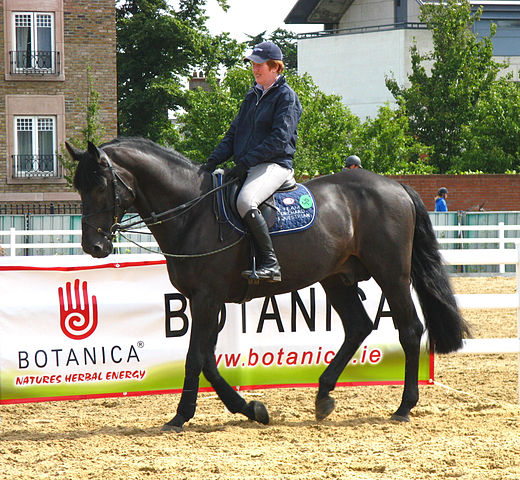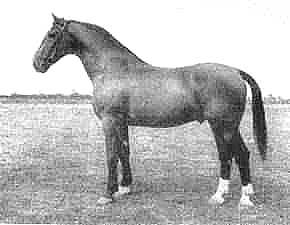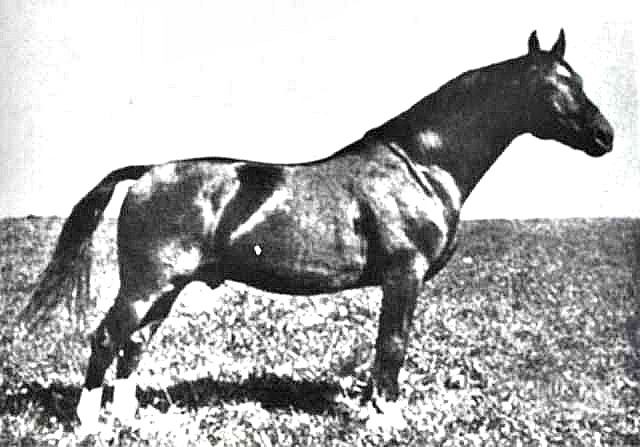Cavalier Royale
- a standout in the breeding of show jumpers -

[Above is one of the many successful offspring of Cavalier Royale HO, the only European warmblood that left a significant legacy of top sport performance in Ireland. This is Chippison ISH, who competed at Olympic and World Championships as a jumper. Cavalier Royale HO has been a standout in the breeding of show jumpers. When I wrote this article six or so years ago I did not have all the information on the jumping trait that I do now, so I will add some depth to the commentary as we go along on its true source. (Photo by Culnacreann and generously made available for the public's use on Wiki Commons]
Cavalier Royale HO has the distinction of being the most successful procreator of top show jumpers in Ireland in recent years; further he is the only sire to produce international level performers from the many imported continental warmblood sires that have stood in Ireland.
Very much like the experience in the US, Ireland imported continental warmblood sires 'in mass' hoping to improve jump and overall sport performance, and like the Americans, in hindsight they can say that very few of these imports fulfilled the promise. Of all those imports brought into Ireland, only Cavalier has produced international jumpers.
Nicholas O'Hare has written extensively and objectively on this issue in Ireland ("The Hammering of the Sport Horse Industry"
www.nicholasohare.com ) and he concluded that "Continental sires apart from Cavalier Royale have made little practical contribution to high performance in Ireland."
Mr. O'Hare has pointed out that in the breeding of show jumpers that the problem does not just rest in the lack of pre-potency in the imported sires, but that the quality of the Irish broodmare herd needs to be upgraded with fresh blood, plus there is a need to install strict performance testing of not only those mares, but of the imported sires and the Thoroughbred sires they use as well.
We want to know how to breed show jumpers successfully. Historically we have found that a great performance horse is not necessarily a great producer, and that if the sport genetics in the good sire are not built on by the dam then the potency he delivers will be halved with each generation. Because this sire: Cavalier Royale HO was so remarkably successful while his peers were not, he is then worth of our study, first to show us what his potency consists of, and then why he was able to pass it on so reliably.
Mr. O'Hare has found that Cavalier is 65% Thoroughbred, and he finds also that the successful Irish sires in sport horse production all have strong Thoroughbred breeding. This too is what I discovered when I examined the genetics of the Hall of Fame Inductees in this country, that it is the
Thoroughbred that is the constant in the most successful sport horses, rather than the warmblood.
The type in sport horse breeding has shifted from twenty years ago- the heavy hunters and the traditional warmbloods have had to move aside for the new lighter and more agile sport horse. At the top level we still find we need the substance these heavier breeds provide, but less of it, and the racehorse and sport saddle horse components have proven to be needed in greater amounts in the mix. Those of us who have not noticed this fact have fallen behind in breeding and performance.
Cavalier is a clear model of this modern type in a sport horse sire. A greater portion of his genetics are from the racehorse (Thoroughbred and Trotter) and much less is taken up with the substance sources (coach and light farm type).
In the real world it is the Thoroughbred that produces more jumpers, hunters, event horses than any other breed. But in the skewed WBFSH 'world' classification we can say the Holstein, and now the Dutch Warmblood (which is largely of Holstein genetics) and the Selle Francais are producing the majority of the top show jumpers. It is easy to assume that because they carry the warmblood breed identification that they are of the old style warmblood. However, this is a deception, because if you examine the genetics of these stars you will find that they carry a significant amount of racehorse. Surely, the fact that these breeds (Holstein & Selle Francais) both emerge from Thoroughbred and Trotter genetics is significant. In this country you will find also that the Thoroughbred rules the genetics of the top show jumpers (see Hall of Fame Show Jumpers). And even when the supposed 'dressage' warmblood lines are extended I have found much to my surprise that they too are largely of Thoroughbred genetics see Verdades DU, Valegro DU, Donnerhall OL and Hall of Fame Dressage.
The modern Holstein was transformed from a light farm breed to a premier coach horse in the mid and late 1800s by huge infusions of Thoroughbred and Yorkshire Coach Horse (a superb trotting carriage horse breed) which had style, substance and speed. The Yorkshire breed was the result of crossing Thoroughbred with Chapman Horse (a breed we know today as the Cleveland Bay).
Therefore there is a good genetic reason why Mr. O'Hare and others have noticed that the Thoroughbred is in force in the good jumpers. I have traced the jumping trait now back to a main root, an early Thoroughbred, with a trotter element, and to his ancestors behind him all the way back to the Hobby (see Standardbred Sport Horses for the full story on this research). It has become evident, that whether from accident or design, the bloodlines that we know today as jumper lines, all carry 'critical mass', first in some main jumper roots (see Legacy of Lexington for the Thoroughbred sources, and Standardbred Sport Horses for those from the Trotter and the main root behind both the jump coming via the Trotter and the Thoroughbred). In our modern day it is the Thoroughbred and the Standardbred that carry the greatest concentrations of those jump genetics. No matter the claims, it is not the European warmblood or its draft horse base that provided the jumping horse, it is the Thoroughbred, the Trotter and the behind it all the Irish Hobby.
Cavalier Royale HO - Pedigree Analysis:
So let's look at what this super star is made of: Cavalier Royale pedigree.
First off- this is a remarkable pedigree design - and it can be hugely instructive to us as breeders if we make the effort to hear what it is telling us. If we examine Cavalier's genetics (through his pedigree which is the map of the genetics) we see quite quickly that there are three strong genetic components (dominance). There are three lines of Heidelberg HO 5x6x7, and it is significant that these are daughter lines and that they reside on the dam side of the lineage. Cavalier's dam has a super broodmare pedigree.
The sire, Cor de la Bryere SF is a giant in sport horse breeding, but this mare is 'off the charts' as well. As we go through this pedigree make a point to notice how strong the maternal factors are.
To understand the journey the Holstein made from a draft horse pulling a plow to a top jumping breed in Europe, you need to understand what was happening in the 1800s. Continental Europe had very few light horse breeds, instead they had multiple draft horse breeds this includes France. All of Europe followed their governing bodies instructions in horse breeding, it was a industry that was overseen nationally, and the infrastructure was proved by the government--that is why there were 'state celles'--centralized breeding, training and marketing areas. Generally farmers kept draft broodmares, and bred them to the state's stallions, and received subsidies and benefits for doing so--it was patriotic to keep a mare and breed it, and thus contribute to the agricultural success of their region.
Draft horses do not make efficient road horses, and once good roads were constructed between communities, it was then the lighter and swifter coach or carriage horse was wanted. And as the 1800s dawned, so did the beginnings of the need for the other type of horse: the coach horse. By the middle of the century Mecklenburg Stud was directed to organize and centralize the production of the coach horse, and Holstein, Hanover and other areas used their stock extensively to cross on their draft horse breed, as well as taking direct importations of the lighter stock into their state studs. What were those coach horse and lighter breeds? They were Thoroughbred, Norfolk Trotter, Anglo-Norman, Anglo-Arab, Irish Hunter, Yorkshire Coach, and even some American Trotter. All those breeds were Anglo developed breeds, the speed, the agility, the stamina, all arrived with the sport based breeds of the British Isles which were imported in huge amounts to the continent. The main bloodlines we will visit below are products of that era.
Heidelberg HO was a light farm/coach Holstein. His genetic dominance is in Elegant HO and Wildfang HO bloodlines. Elegant HO, was as his name suggests, an extremely graceful lighter type coach horse, he was 1/4 Thoroughbred and it showed. His sire is the 1/2 Thoroughbred Ethelbert HO, who is one of the major foundation sires of the modern Holstein. Ethelbert HO was of a more elegant type than his contemporaries, his sire was the Thoroughbred St. Fagans, his dam the coach horse Adolphine HO, a daughter of Hannibal HO, a coach horse with inbreeding to the Yorkshire Coach Horse Burlington Turk 4x4x3x4--which of course set a strong type. Wildfang HO is dominated by Protokol HO (with very little verified pedigree) and the same Hannibal HO mentioned above--therefore the Yorkshire rules the genetics. This is the essence of the coach style Holstein, one of the most consistent jump producers in the European sport horse. We can see then the base of the breeds sport genetics reside in the Thoroughbred and the Yorkshire Coach Horse (trotter).

Heidelberg
Of interest also is St. Fagans, the sire of Ethelbert HO, as his descent is from an Irish Thoroughbred: Faugh-a-Ballagh, who along with his full brother Birdcatcher are known hereditary transmitters of jump in the Thoroughbred. Birdcatcher and his full brother Faugh-a-Ballah are the most powerful jump line found powering the European sport breeds--see Legacy of Lexington for more about the true sources of jump coming via the Thoroughbred to all sporting breeds of today.
There is more to Cavalier's sport genetics as we find four different daughters of Loretto 5x5x5x5 in his dam- this is a filly factor a design which is found in the best stallions and mares. Holstein breeders should cherish the Loretto HO lines they find in their stock and endeavor to build them up. Loretto HO, a very stylish coach type, delivered animated action and charisma to his progeny, he is the source of the old style jump form and he is found strongly also in the super jump sire Landgraf I HO (3x3) through a line of his and as well as one of his 3/4 sister Oina HO. Cavalier also carries a line of Oina HO in his dam quadrant (read more about Loretto here).

Loretto
Another strong filly factor appears in this lineage through the son and daughter of the Thoroughbred mare Trimestal 4x7. If ever there was a case supporting the building up of female influence in a stallion, then Cavalier proves it with this strong maternal construction and his outstanding record as a sire.
The third strong genetic strength in Cavalier is three lines of Son-in-Law 6x6x6, sex-balanced, who is an acknowledged Thoroughbred sport line. It is important to our breeding success to realize it is not enough to add 'types' in our mix, we must identify the superior bloodlines in the TB, warmblood and saddle horse, and then provide a concentration of those lines in our mating designs.
Going back to the front of Cavalier's pedigree we find Ladykiller. The Irish TB Ladykiller established a pure jump line in Holstein, which includes his son Landgraf I HO, one the greatest European sires of show jumpers ever. Ladykiller's potency was in Phalaris/Chaucer. Phalaris is the most prominent line in the modern Thoroughbred and he is a source of impulsion, but also carries faults in his front legs. Chaucer, along with his half-brothers Swynford and Harry of Hereford are sons of Canterbury Pilgrim--who is the prime conduit of the jump to her sons, and are found in the top show jumpers consistently.
In America we find our Hall of Fame show jumpers also carry lines of the English Thoroughbreds Chaucer/Swynford/Harry of Hereford, and the French lines of Le Sancy/Roi Herode/The Tetrarch (also seen in Cavalier), as well as the American sport lines of Fair Play
/Discovery/Man O'War/Mad Hatter/Chance Play and Domino/Black Toney/Blue Larkspur/Ultimus (see
-Hall of Fame Show Jumpers ).These then are proven jump sources. (Major jump lines in America such as Fair Play-Man o" War, Hanover and Domino often carry the root sources of Birdcatcher, Clemence and Canterbury Pilgrim, like their European counterparts, but in addition also carry critical mass in purely American developed root jump transmitters of Lexington RH and Vandal RH (see Legacy of Lexington for the bloodlines and their families).
In addition to the Thoroughbred jump transmitters, we would be foolish not to acknowledge the continual presence of trotter bloodlines in the top show jumpers. It is no coincidence then that the other great producer of jumpers is the Selle Francais, a European breed that is strong in both Thoroughbred and Trotter bloodlines (French Trotter and Standardbred)--the full explanation of the Trotter jump lines and the common root behind both Thoroughbred and Trotters is presented in Standardbred Sport Horses).
What is it in the trotter that contributes to jump ability? Well, first of all it is a racehorse, and so like the Thoroughbred, it produces impulsion genetics. But with a trotter there is also some elevation in its movement, it must lift in the front to produce a trot (we explored some of this in the
Standardbred article). And the sire of Cavalier HO,
Cor de la Bryere SF was pre-potent for lifting and folding of the front legs as well as producing a beautiful bascule over the fence. This style of jumping has proven to make the difference in a good versus great jumper. It was Corde's form of jumping that propelled his descendants to wins at international level. This is how critcal our breeding designs have to become; it is not enough to have the jump, but the style, speed and agility must be there also.
American breeders have resources for sport success at their fingertips. We have the best trotter racer in the world right here: the Standardbred, which carries the greatest concentration of the jumping trait, equal to the Thoroughbred and far greater than any other breeds. How difficult will it be to find the lines in it which will give us the style and form in the jump?
(see Standardbred Sport Bloodlines). We also have the best
Thoroughbred sport sources (contrary to the conventional wisdom spouted at warmblood societies). And the warmblood, the Irish Draught and Cleveland Bay are here in multiples for our substance provision. We have it all here, and it should be our joy and pride to use them in our breeding formulas.
Cavalier HO succeeded as a jump sire in Ireland because of his pre-potency, therefore like other great sires he was able to stamp his type on his offspring. His mates, the Irish broodmares, were able to connect to his genetic power because of the Thorougbred lines thay both carry. And because of the base affinity the Irish Horse has with the Thoroughbred and Trotter because they all emerged from the same sport base: the Irish Hobby.
The constant in sport horse breeding is the Thoroughbred--not the warmblood; in jumpers in particular the other racehorse--the trotter, provides not only strong jumping ability, but the style needed in the modern show jump ring. There is no sport horse without the racehorse.
News from Ireland: as of 2014 a new Irish organization has been formed to protect the traditional Irish Horse, because of the excessive breeding in of continental Warmblood, which has adulterated the bloodlines, there is danger the very qualities that have made the Irish Horse so exceptional will be lost. Concerned breeders in Ireland now have a strong foundation movement in place to preserve their irreplaceable breed:
The Traditional Irish Horse Association For a concise explanation of the problem go to the news section and read the excellent article written by Seamus Davis: "The Traditional Irish Horse- a unique, distinct and separate breed--except in the Irish Horse Register' which covers the problem and the need for immediate action to save their endangered horse. If you are a breeder of Irish Horses you may want to join this movement also.
Related Articles
Cor de la Bryere
The Thoroughbred in Sport Horse Breeding
America's Trotting Racehorse Breed- the Standardbred
Sport 'Bloodlines in the Standardbred
Bloodlines in the Hall of Fame Show Jumpers